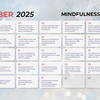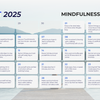You Can’t Improve What You Don’t Measure: A Guide to New Year’s Goal Planning

This is Vicki Mayo, TouchPoints Co-founder, and CEO. I rung in the new year the way I’ve come to love the most – with my family. The last week of December my husband and I recapped 2019 - what worked and what didn’t.
What worked:
- Setting Priorities for the year during January
- Making a list of Top 5 priorities to focus on each week
- Spending time with my family
What didn't work:
- Carving out enough down time
- Working out
- Retiring
Then we strategized for 2020. I hesitate to call it making New Year's resolutions because as I have come to learn from brilliant neuropsychologist and co-founder Dr. Amy Serin, setting goals and the ability to execute them has a lot to do with Executive Functions.
I’ve been doing this goal planning exercise for the past 5 years and I am a big believer. It doesn’t have to be complicated, and only takes a few hours to set it up.
I’m kicking off 30 days of productivity this month and every few days I’ll share my productivity journey.
Here’s my approach to goal planning:
Step 1: Envision Your Desired State.
I highly suggest you carve out at least two hours of interrupted time for this first part. (While I’m not advocating that you should have a glass of wine in your hand, I certainly won’t object). Take a few moments to ask yourself what it is you want your life to look like... What is your living situation like? What do you want it to be? Are you renting and want to buy? Maybe you love where you live but want to be clutter free? What is your family like life? Do you want to spend more time with your kids or maybe carve out more me time? How’s your dating life/marriage? Are you ready to take the next step or maybe break away? Are you as madly in love with your spouse as when you first met? How’s your career? Maybe you want to find a new career? Are you spending time on your hobbies? Are you growing yourself as a person? How’s your health?
Here’s a quick down and dirty list of categories borrowed from "8,760 Hours, How to get the most out of this year." This will help to ensure you hit all the areas important to you.
- Family, Social Life and Relationships
- Career and Work
- Health and Fitness
- Money and Finances
- Emotions and Well-being
- Character and Integrity
- Productivity and Organization
- Adventure and Creativity
- Education and Skill Development
- Location and Tangibles
- Values and Purpose
- Contribution and Impact
As you cover each area jot down your current state and then your future state. Keep space after each life “area.” You’ll use it to make more notes in Step 2.
Step 2: Gap Analysis
After Step 1, you may feel elated – your life is pretty close to where you want it to be! Or you might be dejected – why is there such a big gap? Either way, it’s okay! This process can be quite cathartic. Remember the spaces you made under each life area? Use that space and area by area write down some actionable steps that you could take to get from current state to ideal state. Here’s an example below:
Money and Finances:
What I want (Ideal State): To have my own house! I want to engage in the American Dream of home ownership.
Current State: Renting a 2 bedroom apartment in an expensive desirable part of town and keeping it affordable by renting out a room. But I don't like the roommates constantly rotating. Prefer my own personal space.
Actionable Steps:
- Begin a home down payment savings account.
- Ask HR to redirect 5% of every paycheck into the new account.
- Make an appointment to talk to my banker about getting approved for a loan.
- Pull my credit report from freecreditreport.com
- Ask my realtor friend Megan to set up a drip campaign so I can get familiar with home prices and know when a good deal comes along.
Step 3: Make a Scorecard
Your can’t improve what you’re not measuring. Until now everything you’ve done has been theoretical. Now we’re getting into the meat and potatoes. For each action, break it into an achievable time frame – will this step take a week, a month, or a year?
Use the scorecard template found here or make your own.
List the name of the task. Create corresponding columns at the top to chart your progress Daily weekly or monthly.
This scorecard has two primary functions:
- It creates accountability to keep with your goals and make consistent progress.
- It gives you an immediate dopamine hit when you are able to color in a cell green for on target. Dopamine is a powerful motivator.
Step 4: Track Your Progress
Set up a weekly calendar reminder on the same day of the week every week to update your scorecard. Why weekly? Because checking it weekly gives you at least 52 opportunities to course correct this year. If you really want to up your game you could update daily which gives you 365 changes to improve. If we were playing the lottery I know which odds you would choose! Whichever you choose, please do not forget to update your scorecard at least monthly. It becomes more difficult to stay motivated and you’re less likely to adopt and adhere to the method.
You can make this fun! My husband and I have a mid-month date where we start by sharing our scorecard updates and then get on to the wine drinking portion of our evening. This gives us accountability and lets us share the things we’ve been working on.
Step 5: Do Steps 1-4 Again
I am a firm believer in continuous improvement. Our goal today should be to do a little better than we did yesterday. Every day’s small improvements equate to big improvements in the long run.
The quicker you want to make changes, the more frequently you can repeat steps 1-4. Most people find that doing this once a year and resetting their scorecard at the beginning of every year works. I have some friends who are at critical points in their careers or personal lives who do this full exercise monthly. Find a cadence that works for you and adjust as necessary.
Wishing you well on your journey and Happy New Year!
Vicki mayo is the CEO and co-founder of The TouchPoint Solution, a groundbreaking neuroscience discovery that is embedded in wearables that alleviate stress in as few as 30 seconds, enhance performance, and improve focus. For more information, visit ilovetouchpoints.com.
Related Tools:
Rocketbook Notebook or Dot Journal
Microsoft Excel or Google Sheets




